Latest Designs
Older Versions
Meeting Summaries
Lummi Natural Resources (LNR) Department will be leading efforts next summer to add 3 engineered log structures (ELSs) to the SF Nooksack River, as well as re-route the Skookum Creek Fish Hatchery outlet channel ~350 feet upstream. This project, Skookum Edfro Phase 1 Adaptive Management (AM), began construction in the summer of 2025. A contractor began the new outlet channel. However, federal permitting delays also delayed CLOMR issuance, and LNR had to postpone ELS construction to 2026. It was decided to postpone Phase 3 until 2027 to avoid regulatory delays.
The overall goal for the Skookum Edro Phase 3 Restoration Project began with the Lummi Natural Resources (LNR) Department engaging with stakeholders in developing a design concept that restores salmon spawning,
rearing, and holding habitat in the South Fork Nooksack River from
river mile (rm) 12.8 to 13.9. Stakeholders provided input, and LNR responded with a conceptual design (above). A Preliminary Design with a Basis of Design (BOD) was completed and is attached. The BOD includes the 3 project alternatives we presented at a 2023 Community Workshop. The project will be going through a Conditional Letter of Map Revision (CLOMR) through FEMA to receive its Floodplain Development permit. ESA consultation will occur simultaneously. LNR is submitting permit applications for ESA consultations this winter of 2024/25. The CLOMR review and ESA consultation will occur concurrently during winter of 2025. Project implementation is expected in 2026. More information is summarized below in the Project Development section about the next steps required for project implementation.
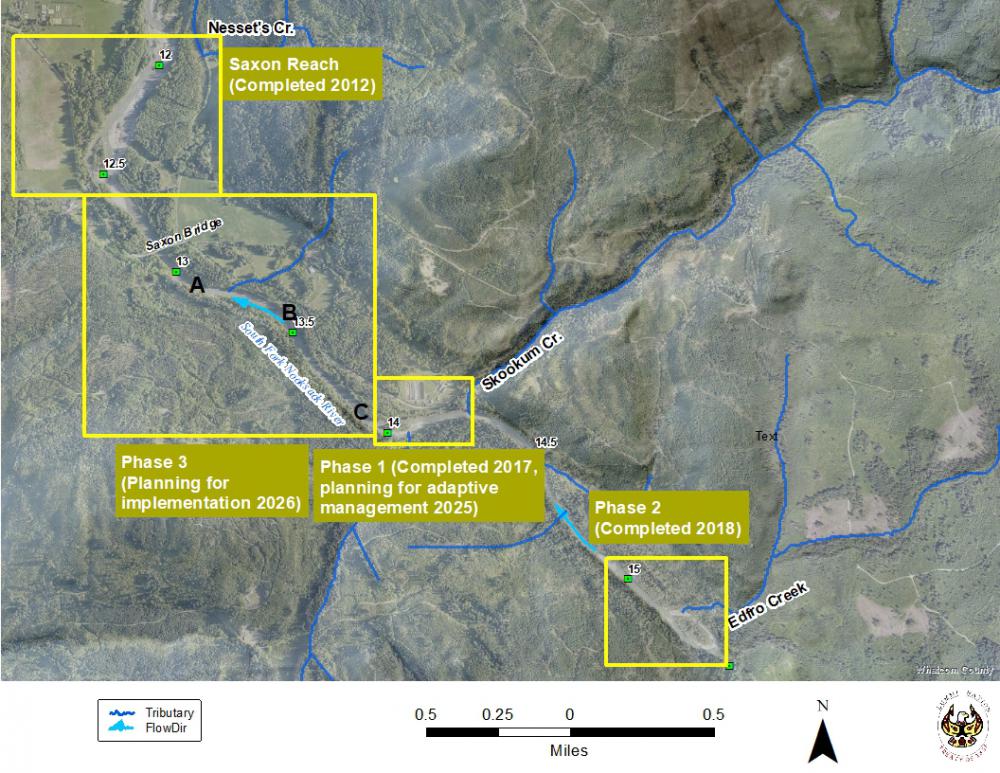 Total site map, showing implementation year and current schedule. Letters denote photo locations. Flow is from right to left.
Total site map, showing implementation year and current schedule. Letters denote photo locations. Flow is from right to left.The project reach is used for chinook holding, spawning, and rearing with over 90 redds observed since 1986, including 40 redds observed in 2022. The project reach is a hot spot for adult holding chinook as they migrate to the hatchery and upstream spawning grounds. This design should
result in self-sustaining salmon runs at harvestable levels, and increased
flows in the channel and available floodplain to reduce flooding to downstream
properties.
Skookum Edfro Phase 1 Adaptive Management
LNR and its engineering team developed designs to adaptively manage the Skookum Edfro Phase 1 Restoration Project to encourage more flow to the Skookum Creek Fish Hatchery outfall. Phase 1 was built in 2017 and this design will work in the same area, between approximately the Skookum Creek confluence (rm 14.3) to around the island (rm 14). Phase 1 Adaptive Management will address the chinook mortality event of 2021, along with additional mortality events in each year since. The hatchery outlet channel is where Lummi hatchery brood stock chinook returns to spawn, and is located in the right (north) side channel next to 'Skookum Island'. The side channel contains too low of flow when adult chinook return in August through early October. Three engineered log structures (ELSs) will be installed in the river channel to create holding pools for adult salmonids. Habitat structures will be placed in the hatchery channel. An emergency vault will be built in the hatchery channel in the existing hatchery channel. The project is out to bid now, with bids due on June 10th, 2025. The bid-level design is attached.
Flood Risk
Results of a recent Climate
Impacts Risk Assessment show that there will be more frequent and intense
floods in the future. The recent flooding throughout Whatcom County highlights
the need to reduce flood risk for properties in flood prone areas.
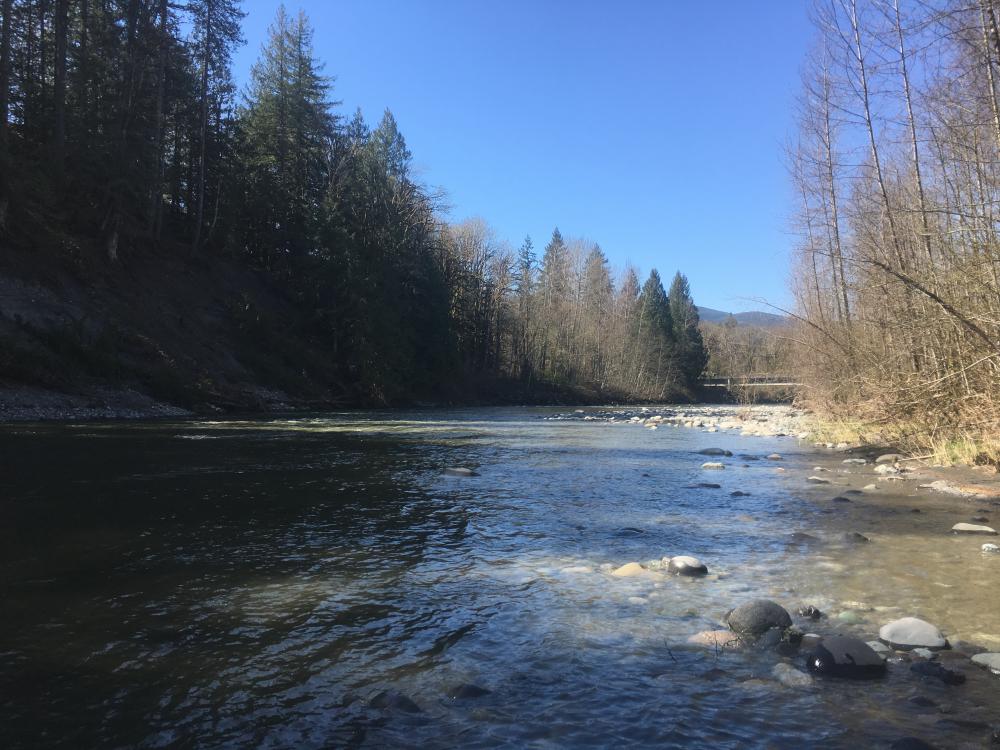 South Fork Nooksack River at river mile 13.15 looking downstream. The project reach is low-gradient with high quality chinook salmon spawning, rearing, and holding habitat potential. Location A on map.
South Fork Nooksack River at river mile 13.15 looking downstream. The project reach is low-gradient with high quality chinook salmon spawning, rearing, and holding habitat potential. Location A on map.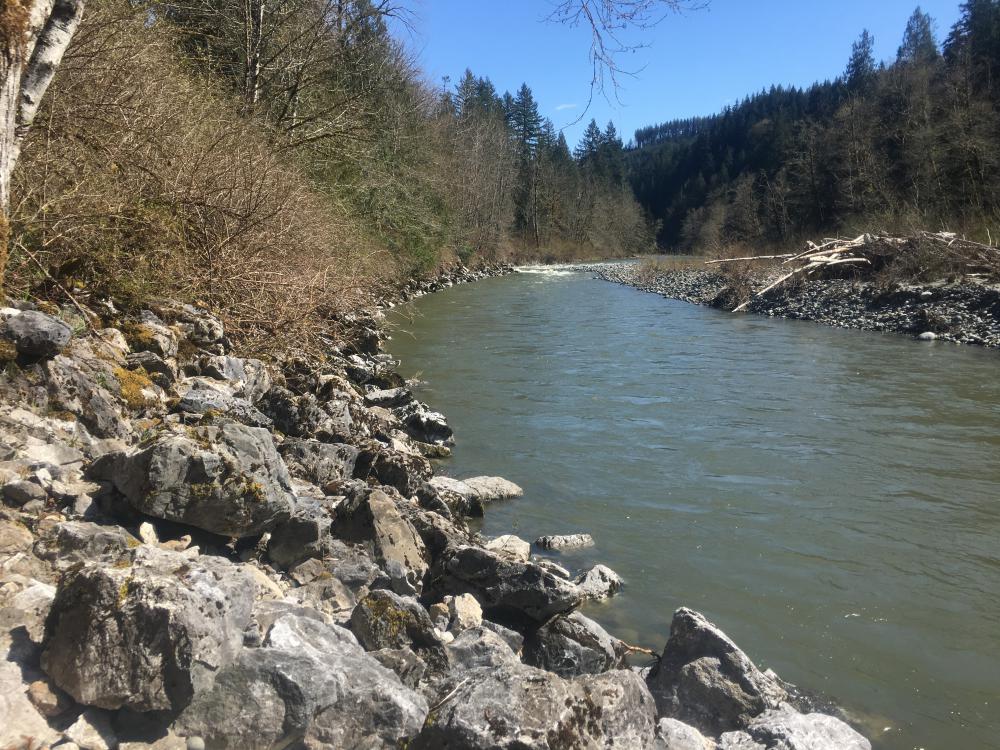 Jagged boulders along the edge of the river (sometimes referred to as riprap) form homogeneous in-stream habitat, but there is excellent floodplain potential in this location. Location B on map.
Jagged boulders along the edge of the river (sometimes referred to as riprap) form homogeneous in-stream habitat, but there is excellent floodplain potential in this location. Location B on map.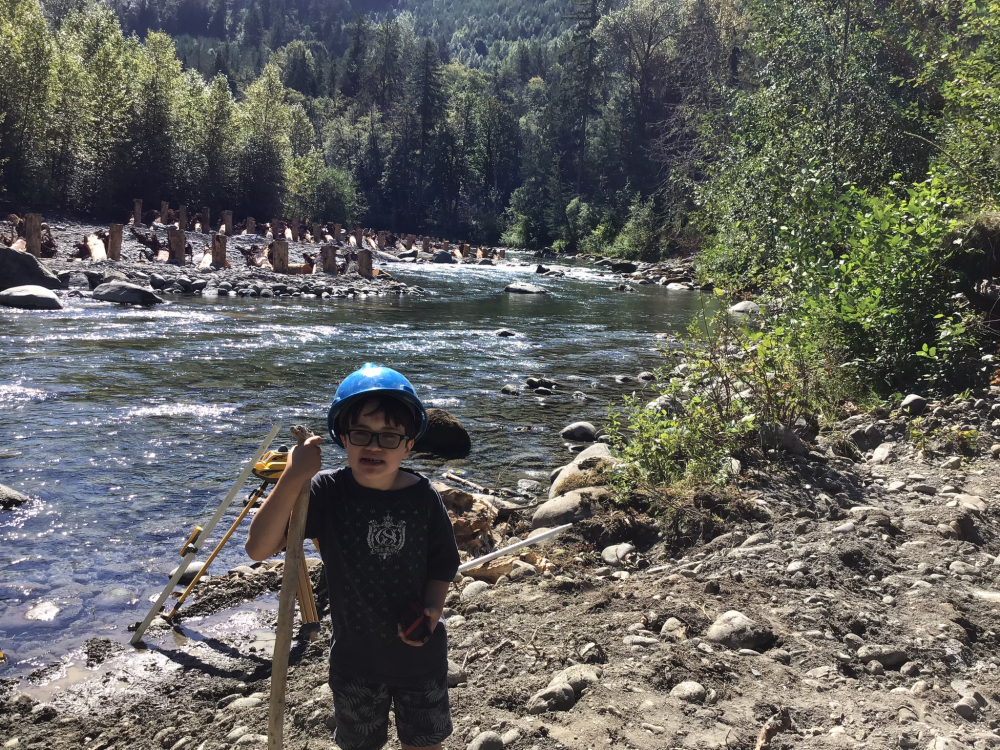 Everyone gets to help restore the South Fork!
Everyone gets to help restore the South Fork!
Chinook Salmon
The South Fork Nooksack River is home to three species that
are listed as threatened on the Endangered Species List: chinook, steelhead,
and bull trout. Habitat degradation is the leading cause for the decline of
WRIA 1 (Nooksack Watershed) salmonid populations (WRIA 1 2005).
A recent die-off of over 2,500 South Fork Nooksack early
Chinook in September 2021 illustrates the severity of the habitat problems that
are now being exacerbated by climate change. Most of the mortalities occurred
in the project reach (LNR 2021), highlighting the need for habitat restoration. The photo below was presented on a 60 Minutes segment (the Vanishing Wild) that aired on January 1, 2023 (0:30 to 3:00 at https://www.youtube.com/watch?v=6TqhcZsxrPA or 15:15 to 18:05 at https://www.cbsnews.com/video/60minutes-2023-01-01/#x)
Fact sheet of 2021 Chinook Mortality Event
909.3KB
(2022) Lummi Nation
Update 2022: Lummi Nation Response to Chinook Mortality Event
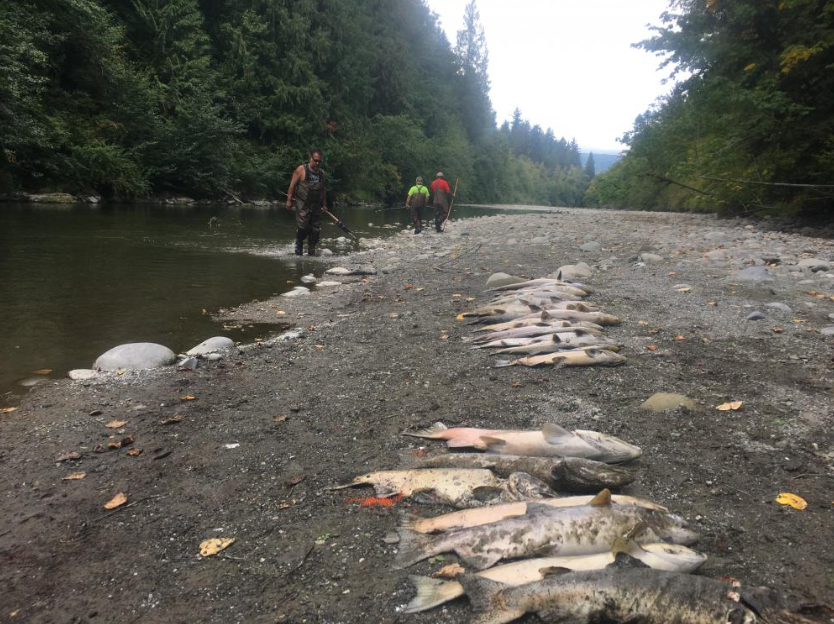 Adult chinook mortality event. September 2021. From left: Frank Lawrence III, Alex Levell, and Chris Phair. Location C on map.
Adult chinook mortality event. September 2021. From left: Frank Lawrence III, Alex Levell, and Chris Phair. Location C on map.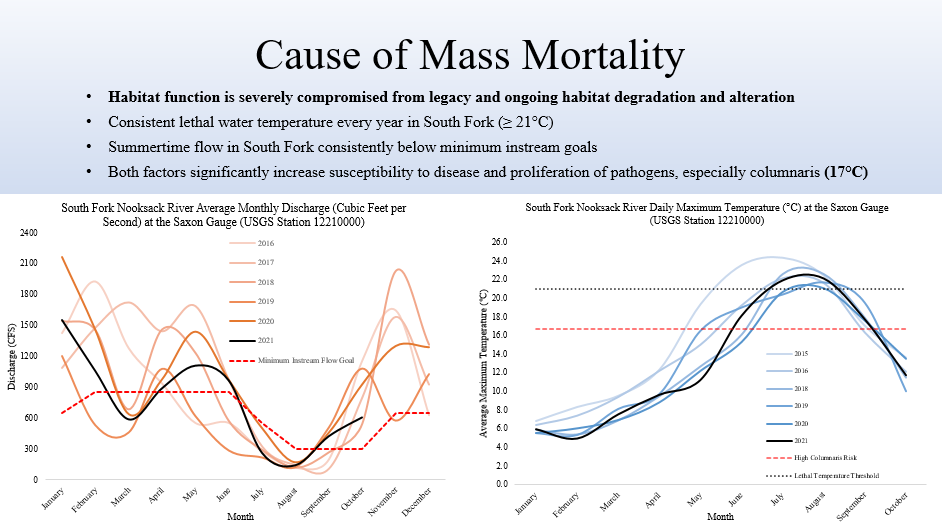 The root cause of the mortality event is severely compromised habitat function from legacy and ongoing degradation and alteration.
The root cause of the mortality event is severely compromised habitat function from legacy and ongoing degradation and alteration.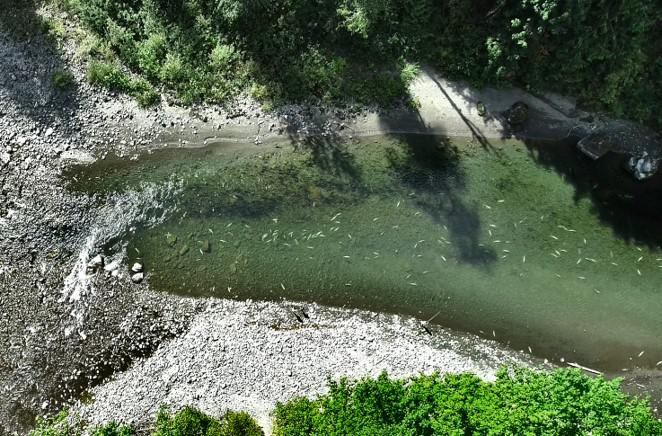 Here are several dead chinook as seen from an overhead drone. Flow is from left to right. Location C on map.
Here are several dead chinook as seen from an overhead drone. Flow is from left to right. Location C on map.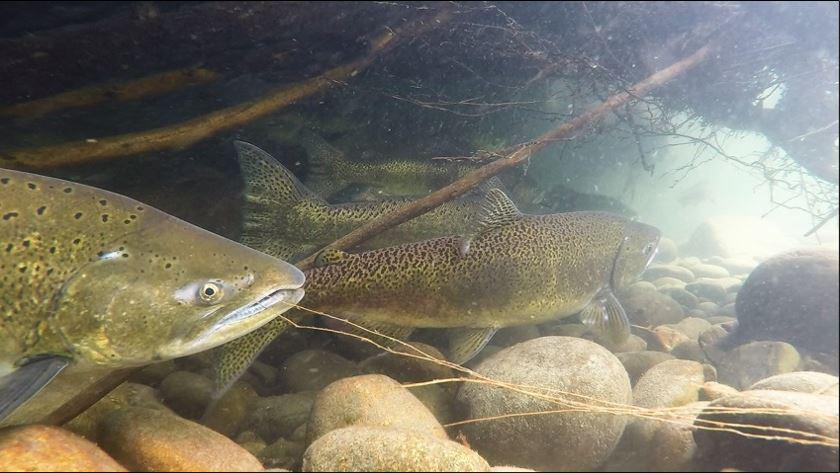 This is more like our goal! Adult chinook salmon holding under an ELJ in the lower South Fork Nooksack River. Photo composed by Ian Smith.
This is more like our goal! Adult chinook salmon holding under an ELJ in the lower South Fork Nooksack River. Photo composed by Ian Smith.Skookum Edfro Phase 3 Restoration Project Development
The 2020 rescindment by FEMA of the “Policy on Fish Enhancement Structures in the Floodway” led to several hydraulic modeling iterations to lower WSE rises at insurable structures. The proposed means to prevent rises and build the project is to excavate up to 85,000 CY from banks and side channels. The excavations will increase channel area, with removed trees to be built into the ELJs. Some removed alluvium will be placed in the areas of ineffective flow immediately downstream of the ELJs. Other excavated material will be hauled off-site to nearby quarries. The engineers will be adjusting models to reduce excavation amounts from the banks. Accretion of gravels following high flow events will replace the excavated bank footprints as the channel adjusts. LNR will allocate funds from a recent BIA award to procure the bank excavation costs and will not require RCO funding.
Climate change is occurring and is expected to increase both the frequencies and magnitudes of high flows. The engineers are designing structures to be stable over a range of likely higher flows.
To support LNR with implementing the early stages of the Phase 3
project, Herrera Environmental Consultants, Inc. (Herrera) has summarized the existing (pre-project) geomorphic and hydraulic conditions and
habitat restoration opportunities within the Phase 3 reach (attached at top of site). Herrera developed a
two-dimensional (2D) hydraulic model of the Phase 3 reach following a site
visit to it on September 15, 2022. Herrera used the model results and
observations of the current geomorphic and habitat conditions of the reach made
during the site visit to identify habitat restoration opportunities, and to
identify existing flood and geomorphic related risks (i.e., bank erosion,
channel migration and channel avulsion) to nearby infrastructure and private property.
The general approach to improving habitat
conditions in the Phase 3 reach is to implement restoration measures that
promote the natural physical processes that create and sustain diverse and
complex habitat conditions that ultimately promote recovery of ESA listed
salmon species including Puget Sound Chinook, Steelhead and Bull Trout.
Specifically, recovery of the South Fork early Chinook is essential to
recovering the threatened Puget Sound ESU and for restoring runs to sustainable
and harvestable levels for local tribal communities. Therefore, the restoration
strategy is to achieve increased habitat function through restoring lost
channel processes and conditions by emulating, to the greatest extent possible, the
probable historical stream and channel conditions with immediate and/or
near-term benefits under a range flows and conditions, for as long a duration
as possible. To accomplish this WRIA 1 co-managers established target habitat conditions for the South Fork restoration project elements and
performance monitoring. Herrera and LNR are developing designs matching such targets. The existing conditions and restoration opportunities report is at the top of this site.
The project team presented 3 draft concepts at the June 14, 2023 Community Workshop #2. We received feedback from the meeting attendees and proceeded with the preferred alternative. The FEMA no-rise policy, however, is limiting restoration opportunities. Herrera designed lower profile ELJs, moved banks back, and excavated wider forested floodplain channels to limit rise. The preferred alternative was adjusted to lower water surface elevation (WSE) rise on insurable structures. Thankfully, the preliminary design remains similar to the preferred alternative selected by stakeholders at the 2nd community workshop.
Here is a summary by the engineer of record for the preferred alternative:
- We are expanding the
channel width (generally through the reach from RM 13.2 to 13.8)
- Trying to hold the right
bank firm, and more expansion to the left bank.
- For the narrow straight
part of the channel (between convergence pool and Saxon Road area from RM
13.6 to RM 13.8) we will need some right bank offset because the left bank
has limited expansion opportunities. There we will offset the right
bank back to the existing high flow side channel to retain the existing
top of the higher bank (i.e., removing that right bank terrace).
- Maintaining the 4 ELJs
along Saxon Road between RM 13.25 and 13.5 (because we know we will need
something there to roughen and keep the channel from incising and having
the left bank point bar grow again).
Skookum Edfro Phase 1 Adaptive Management Restoration Project Development
Phase 1 Adaptive Management would place three engineered log jams (ELJs) on the right bank as well as reconfigure a hatchery channel providing upstream passage for returning adult chinook salmon. The CLOMR would revise three Federal Emergency Management
Agency (FEMA) Flood Insurance Rate Maps (FIRMs).WSE (2024) prepared updated hydraulic modeling and floodplain mapping to support a Conditional Letter of Map Revision (CLOMR) request. The CLOMR would revise three Federal Emergency Management Agency (FEMA) Flood Insurance Rate Maps (FIRMs).
Because the proposed elements include changes within the floodway, FEMA requires certification that no structures are affected by BFE increases (WSE 2024). Modeling of the proposed condition shows no impacts on BFEs at insured structures. A short segment of the ditch downstream of the outlet channel will be filled by the new berm to possibly mitigate additional floodplain flow.
Community Engagement
Engagement opportunities include:
- Stakeholder Site Walk was
- Stakeholder Site Walk was held on May 22, 2024. The LNR project team, including engineers and outreach consultants, and most adjacent landowners walked the site to review proposed alternatives. Landowners from the WLT witnessed areas of proposed bank excavation that is needed for floodway conveyance. The engineers explained where the proposed engineered log structures (ELS) will be located. LNR discussed proposed staging areas with landowners, as well as access routes.
- Community workshop #2 was held on June 14, 2023, at the Acme Presbyterian Church from 5:00 to 7:00 pm. Meeting notes and the presentation will be posted to the top of this page soon. Early design concepts were showcased and discussed at the workshop. These are posted in the presentation.
- Community workshop #1 was held on November 15, 2022, at the Acme Presbyterian Church from 5:30 to 7:30 pm. Meeting notes and the presentation links are at the top of this page. The team introduced existing conditions and solicit feedback to select the preferred alternative. We were excited to see the interest that the attendants had in this project. Many of the community member's requests are currently being addressed are also linked above, including Lummi Nation response to the mortality event.
- Participation in Acme-VanZandt Subzone - LNR and Veda introduced the project at the January 19th, 2022 meeting.
- Frequent communications provided via a Listserv
and updates to this website,
- Presentations and in-person meetings with
landowners, stakeholders, and established forums,
- Two stakeholder meetings to share results of
technical work and gather input from community members,
- Other group and individual meetings. The team has met individually with one landowner and will continue to do so per request.
The project team is deeply committed to working with and
engaging stakeholders through the duration of this project.
Letter to Subzone
415.2KB
(2021) Alex Levell/Melanie Del Rosario
Stakeholders will have opportunities to weigh in on various topics, including but not limited to:
- the scope and scale of the problems the project
is intended to address,
- prioritization approach and criteria for design
alternatives, and
- the preferred design alternative.
FUNDERS
- Washington State Recreation and Conservation Office - Salmon Recovery Funding Board (SRFB)
- BIA TCR
- National Fish and Wildlife Foundation (ATBC)
- Washington State Department of Fish and Wildlife (HSIL)
- Whatcom County PUD
- Northwest Indian Fisheries Commission
PARTNERS/SPONSORS
- Lummi Nation, with support from Herrera Environmental Consultants and Triangle Associates
- Private landowners (essential players)
- Whatcom County Public Works
- Whatcom Land Trust
- Washington State Department of Natural Resources Aquatics
- Acme VanZandt Flood Control Subzone Committee
- Salmon Recovery Staff Team
- Nooksack Watershed Staff Team
For more information, please contact Alex Levell: alexl@lummi-nsn.gov
Salmon Recovery Funding Board Grant Proposal
647.7KB
(2021) Kelley Turner/Alex Levell/Alissa Ferrell
2021Natural Systems Design and Lummi Nation Natural Resources Department
Upper South Fork Nooksack River Effectiveness Monitoring Report
https://www.lummi-nsn.gov/userfiles/934_SFNooksackEffectivenessMonitoringReportFinal.pdf16.8MB2021-11-12 11:31:221747